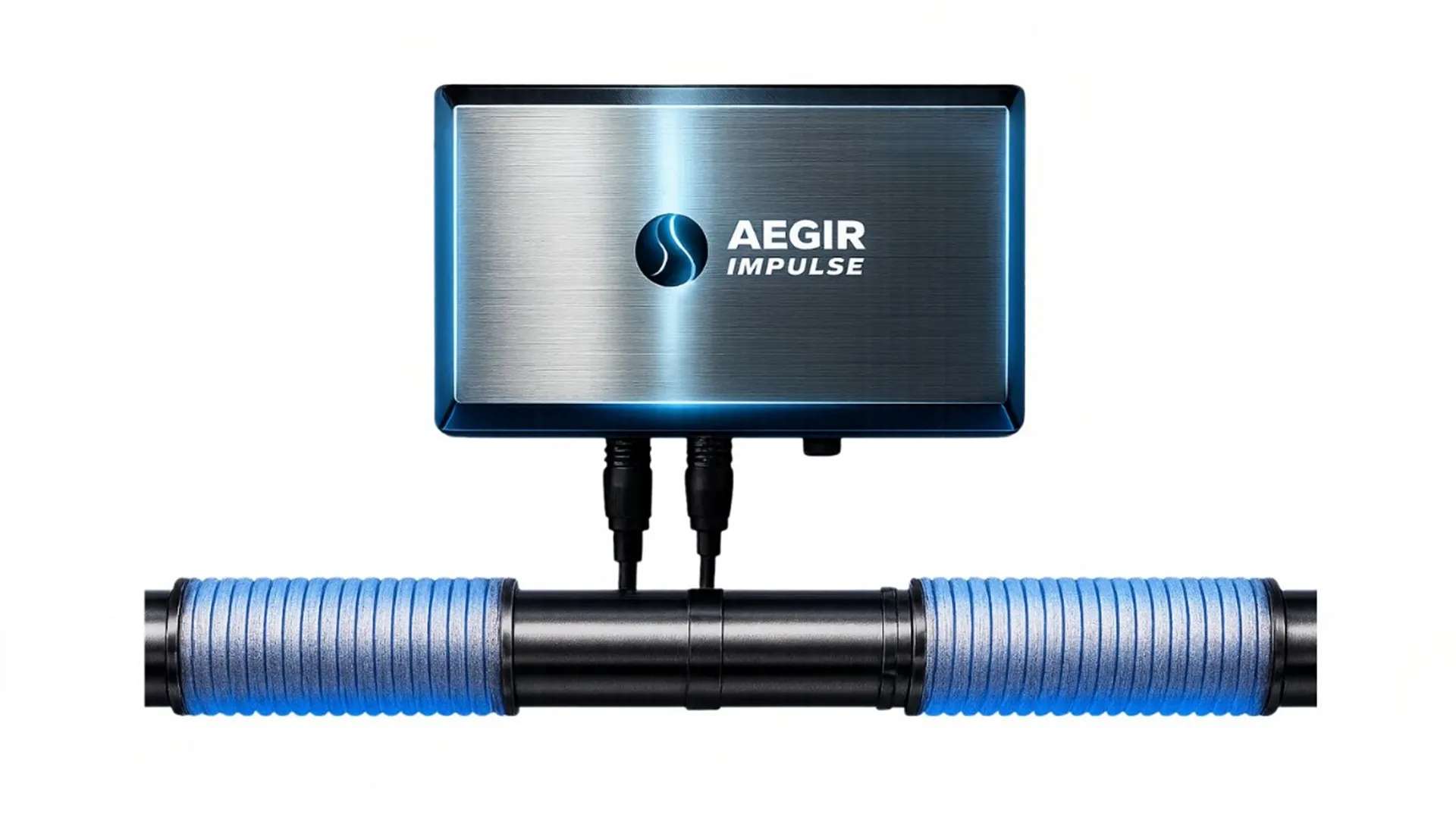Aegir Impulse

Aegir Impulse – A revolution in water purification technology.
The impulse technology uses advanced frequency control that alters the structure of the liquid through carefully tuned electromagnetic and acoustic frequencies. By affecting the molecular composition of the liquid, processes are created that lead to improved water quality, prevent scale deposits, dissolve pollutants and eliminate microbial growth as well as protect systems against corrosion – all without chemicals.
Aegir Impulse – How Does It Work?
Aegir Impulse uses a special configuration of copper wires to generate an electromagnetic field. The copper cables are wound both clockwise and counterclockwise, creating a space between the windings where a varying magnetic field arises. When electrical current passes through these windings, specific frequencies are induced in this field, affecting the water flowing through the pipe.
This impact results in two important processes:
- Formation of nanobubbles
Nanobubbles are extremely small gas bubbles, usually less than 200 nanometers in diameter. They are formed through a rapid cavitation effect where the liquid expands and compresses in microscopic waves.
These nanobubbles have unique properties:
- Dissolve impurities and deposits: They can penetrate microcracks and break down rust, mineral coatings, and biofilm.
- Improve oxygen uptake and oxidation: The high oxygen concentration in the nanobubbles accelerates the breakdown of organic substances.
- Eliminate bacteria and viruses: Nanobubbles, especially those containing oxygen, generate reactive oxygen species (ROS) that destroy microorganisms by breaking down their cell walls.
- Crystallization of calcium – preventing limescale
Aegir Impulse converts calcium bicarbonate (Ca(HCO₃)₂) into calcium carbonate (CaCO₃) by altering the structure of the water.
The reaction looks like this:
Ca(HCO3)2+IMPULSE→CaCO3(monocrystals)+CO2+H2OCa(HCO₃)₂ + IMPULSE → CaCO₃ (monocrystals) + CO₂ + H₂OCa(HCO3)2+IMPULSE→CaCO3(monocrystals)+CO2+H2O
- Prevents limescale deposits: By controlling how calcium ions bind together, the limescale crystallizes into monocrystals, preventing it from sticking to pipes or heating elements.
- Protects piping systems and installations: Reduced limescale formation leads to better energy efficiency, longer equipment lifespan, and less maintenance.
What Makes Aegir Impulse Unique?
Aegir Impulse combines these two processes in a self-operating system, where nanobubbles and monocrystals are continuously formed and broken down.
- 100% chemical-free water treatment
- Eliminates microbial growth and improves water quality
- Reduces corrosion and rust in piping systems
- Optimizes oxygen uptake and improves fluid properties
- Protects equipment by preventing limescale deposits
By changing the structure of the water at a molecular level, we can optimize its properties for a more sustainable, efficient, and environmentally friendly future.
Aegir Impulse is the future solution for water treatment – based on science, technology, and natural processes.
In this study, the effect of electromagnetic fields (EMF) on membrane fouling and scale control during desalination of brackish groundwater using a pilot-scale reverse osmosis (RO) system was investigated. The groundwater consisted mainly of CaSO4 with a total dissolved solids concentration of 5850 mg/L and a hardness of 2500 mg/L as CaCO3. Two EMF devices were installed in the pipeline upstream of the cartridge filter and at the RO feed inlet to induce an electrical signal at ±150 kHz to the groundwater.
The effect of EMF on membrane scaling was assessed under accelerated conditions, i.e., without pH adjustment and addition of an antiscalant. Two-phase experiments were conducted: phase 1 (376 hours) with EMF devices turned on after 150 hours of baseline operation and phase 2 (753 hours) with EMF devices turned on from the beginning of the study.
EMF significantly reduced membrane fouling and improved RO performance by 38.3% and 14.3% in terms of normalized decline in water permeability after 150 hours and 370 hours of operation, respectively. The results of the autopsy of the membranes showed that the coating layer formed during EMF was loosely packed with low density and easily removable by hydraulic flushing.

